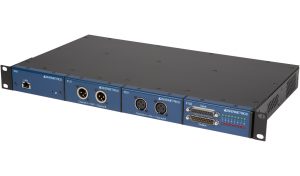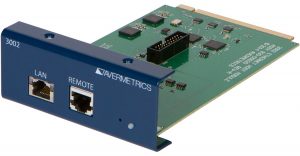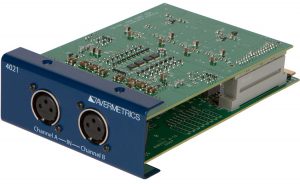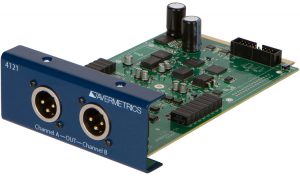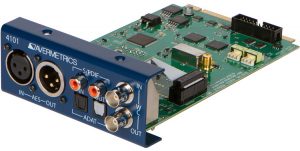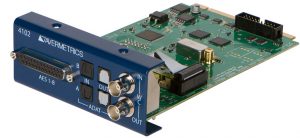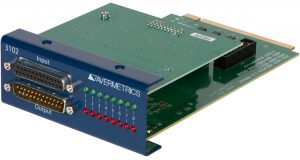AverLine has been engineered from the ground up for production line testing of electronic products, subassemblies, boards, and components. It was designed by an engineering team with extensive product development and testing experience, with performance and the total cost of testing as clear design criteria.
This system, and the currently available range of plug-in modules, offers a wide range of test capabilities, from professional, semi-professional, and consumer audio product testing, to basic board level tests, to process control, and more. New modules to add new tests are being added to the library every day.
This is a modular system using a custom 1U rack designed to hold up to 4 modules. The system is highly scalable: Racks may be interconnected using the AVERLINK connectors on the back of each rack unit; up to 64 rack units holding up to 254 modules can be connected in a single system. Internally, each module has an array of processors, and the system is organized as a large, interconnected two-dimensional array of these processors in a distributed intelligence configuration. Because each module is intelligent it does its own analysis, so tests across multiple modules occur in parallel, significantly reducing testing time.
Modules
3002 Ethernet Host Adapter
Every system has one (and only one) Ethernet Host Adapter module. This module provides communication between the system and host computer, and performs test scheduling and results formatting tasks during test execution. Communication with the module is done via Telnet, and an embedded web server provides access to configuration settings and status information. A white front panel LED indicates system activity and status. A Remote Operator port is provided for future expansion.
4021 Analog Audio Input Module
Any number of 4021 Input modules may be installed in a given system. This module provides two high-performance audio inputs, supporting tests over the entire audio spectrum and a wide range of signal levels. Each channel operates simultaneously and independently, doubling effective throughput compared to conventional audio test systems. Multiple modules in a system all operate in parallel, greatly reducing test time for multi-channel measurements when compared to switched, repetitive testing.
4121 Analog Audio Generator Module
Any number of 4121 Generator modules may be installed in a given system. This module provides two high-performance audio outputs, providing audio stimulus signals over the entire audio spectrum and at a wide range of signal levels. Each output may be set to different frequencies and/or levels. Three very low distortion oscillators are available for generating complex stimulus signals and may be assigned in any combination to either or both outputs.
4101 Digital Audio Module
This module has male and female XLR connectors, Toslink optical input and output connectors, two RCA coaxial connectors, and two BNC connectors on the front panel. The XLR connectors provide two channels of transformer-coupled AES/EBU input and output while the optical connectors support ADAT format digital audio as well as optical S/PDIF.
All inputs and outputs are capable of operation at sample rates from 44.1kHz to 192kHz, with 24-bit resolution. Data synchronization may be derived from internal, Word Clock (WC), or extracted from any of the input data streams. In addition, a Word Clock output is available that provides a frame rate signal for use with synchronizing external devices or additional 4101 or 4102 Digital Audio modules.
4102 Digital Audio Module
This module has a female DB-25 connector for AES/EBU, two each Toslink optical input and output connectors, and two BNC connectors on the front panel. The DB-25 connector supports 8 channels in and out of transformer-coupled Tascam (TDIF) format AES/EBU digital audio. The optical connectors support ADAT format digital audio as well as optical S/PDIF. Up to 16 channels of ADAT are handled by two input and two output connectors.
All inputs and outputs are capable of operation at sample rates from 44.1kHz to 192kHz, with 24-bit resolution. Data synchronization may be derived from internal, Word Clock (WC), or extracted from any of the input data streams. In addition, a Word Clock output is available that provides a frame rate signal for use with synchronizing external devices or additional 4101 or 4102 Digital Audio modules.
3102 Isolated I/O Module
This module provides eight opto-isolated inputs ,eight reed relay SPST outputs, and a fully isolated power supply. This supply can provide power for small external sensors and other test-fixture circuits, and in some situations may simplify external connections to the system.
Because the inputs, outputs, and power are all completely isolated from the system ground and internal signals, this module is perfect for controlling processes in noisy environments or adjusting sensitive analog signals internal to test devices.
The eight opto-isolated inputs can be used to sense the state of external signals, such as proximity switches, out of limit sensors (overtemp, overvoltage, etc.), switch closures, test status, and other binary events. Similarly, the eight reed relay outputs can be used to close circuits during board-level tests, actuate motors, valves, or other process control components, light annunciators, etc. These are very high reliability relays; they are rated at 109 cycles at low signal levels, and can handle up to 10W.
Eight Green LEDs indicate the state of the opto-isolated input signals, while eight Red LEDs indicate the state of the reed relay outputs for easy visual feedback.

